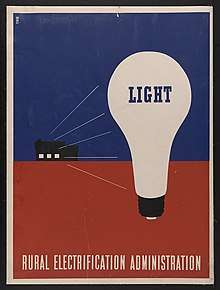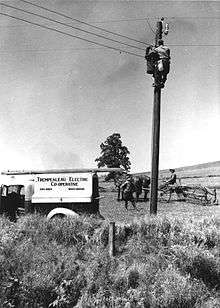Rural Utilities Service
The United States Rural Utilities Service (RUS) administers programs that provide infrastructure or infrastructure improvements to rural communities. These include water and waste treatment, electric power, and telecommunications services.[1] it is an operating unit of the USDA Rural Development agency of the United States Department of Agriculture (USDA). It was created in 1935 as the Rural Electrification Administration (REA), a New Deal agency promoting rural electrification.
A total of 890 rural electric and 800 rural telecommunications utilities in 47 states, Puerto Rico, the Virgin Islands, Guam, the Marshall Islands, the Northern Mariana Islands, and the Federated States of Micronesia have received financial assistance. Approximately 7,200 rural communities are served through financial assistance received from water and waste loans and grants.[2]
The RUS administers the following programs:
- Water and Environmental: provides financial assistance for drinking water, sanitary sewer, solid waste and storm drainage facilities in rural areas and communities with a population of 10,000 or less.[1]
- Electric Programs: help maintain, expand, upgrade and modernize the rural electric infrastructure. It also supports demand-side management, energy efficiency and conservation programs, and on-and off-grid renewable energy systems.[1]
- Telecommunications: helps deploy the rural telecommunications infrastructure.[1]
Rural Electrification Administration


RUS originated with the Rural Electrification Administration (REA), one of the agencies created under the New Deal in 1935 to promote rural electrification. In the 1930s, the U.S. lagged behind Europe in providing electricity to rural areas. In 1934, less than 11% of U.S. farms had electricity. That same year, in France and Germany, nearly 90% of farms had electricity.
Backed by the 1936 Rural Electrification Act the REA gave loans and other help to rural organizations setting up their own power systems and was one of the New Deal's most successful programs.[3] By 1937, hundreds of new municipal power utilities were created nationwide. In 1939, 288,000 households had their electricity provided by rural electric cooperatives. Most of these electric co-ops had applied for and received loans from REA. By 1942, nearly 50% of US farms had electricity, and by 1952 almost all US farms had electricity.[4]
In 1949, the REA became authorized to provide loans to rural telephone cooperatives.[5]
Under the Department of Agriculture Reorganization Act of 1994 the REA was absorbed by the Rural Utilities Service (RUS).[6]
References
- "Rural Utilities Service". USDA. Retrieved 3 March 2016.
- "Rural Utilities Service". Federal Register. Retrieved 3 March 2016.
- McChesney, Paul; Podesta, John. "Let There Be Wi-Fi". Washington Monthly. Retrieved 3 March 2016.
- FDR: The New Deal Years, 1933–1937, pages 491–92, by Kenneth S. Davis. Published by Random House, 1986
- "History of Rural Telecommunications". The Rural Broadband Association. Retrieved 3 March 2016.
- Laurence Malone (March 16, 2008). "Rural Electrification Administration". In Robert Whaples (ed.). EH.Net Encyclopedia. Economic History Association. Retrieved July 31, 2016.
External links
![]()
